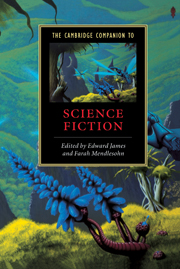Book contents
- Frontmatter
- Introduction
- Part 1 The history
- Part 2 Critical approaches
- Part 3 Sub-genres and themes
- 11 The icons of science fiction
- 12 Science fiction and the life sciences
- 13 Hard science fiction
- 14 Space opera
- 15 Alternate history
- 16 Utopias and anti-utopias
- 17 Politics and science fiction
- 18 Gender in science fiction
- 19 Race and ethnicity in science fiction
- 20 Religion and science fiction
- Further Reading
- Index
- Series List
11 - The icons of science fiction
from Part 3 - Sub-genres and themes
Published online by Cambridge University Press: 28 May 2006
- Frontmatter
- Introduction
- Part 1 The history
- Part 2 Critical approaches
- Part 3 Sub-genres and themes
- 11 The icons of science fiction
- 12 Science fiction and the life sciences
- 13 Hard science fiction
- 14 Space opera
- 15 Alternate history
- 16 Utopias and anti-utopias
- 17 Politics and science fiction
- 18 Gender in science fiction
- 19 Race and ethnicity in science fiction
- 20 Religion and science fiction
- Further Reading
- Index
- Series List
Summary
The feature that unites every kind of sf is the construction - in some sense - of a world other than our own. This may be another planet (or even another universe); or it may be a 'future world' in which conditions have changed in some dramatic way. But whatever new conditions or circumstances apply - alien invasion, Martian colonies, a permanent cure for the ageing process - the writer has to signal the changes, and the reader has to be able to understand the significance of these signals. Thus, the reading of an sf story is always an active process of translation. What are we being told about the characters, the politics, the social conditions of the imagined world, through the medium of these bizarre artefacts, landscapes, relationships, industries and customs? The icons of sf are the signs which announce the genre, which warn the reader that this is a different world; and at the same time constitute that difference.
More than in any other fiction, in sf the imaginary setting is a major character in the story – and this fictional surface is held together by the highly foregrounded description of unreal objects, customs, kinships, fashions, that can be identified and decoded by the reader. The word ‘icon’ is derived from the Greek eikon – it means an image, but the term came into English usage via Byzantine art, where an ‘ikon’ is, specifically, a stylized representation of Christ or one of the saints. Similarly, an sf icon will represent something both supernatural (or at least other-worldly), artistically conventional (in that certain features are mandatory) and yet clearly belonging to the public domain. Just as Mary Shelley’s Dr Frankenstein constructed the monster rather than ‘inventing’ him, it is probably fruitless to trace any of the icons of sf back to a single, original author.
- Type
- Chapter
- Information
- The Cambridge Companion to Science Fiction , pp. 163 - 173Publisher: Cambridge University PressPrint publication year: 2003
- 8
- Cited by



